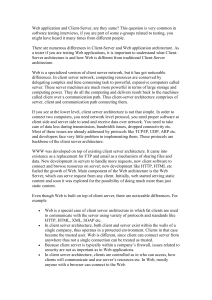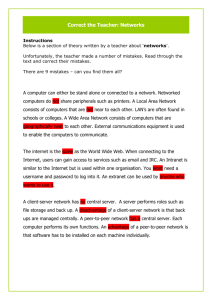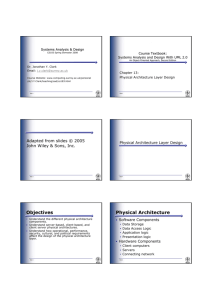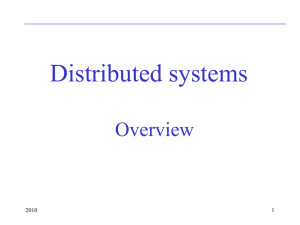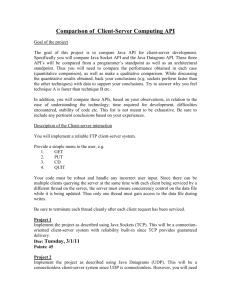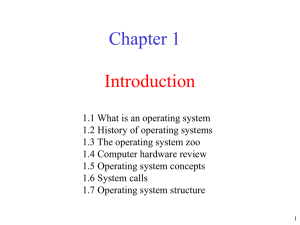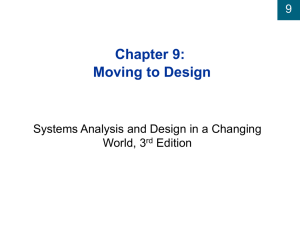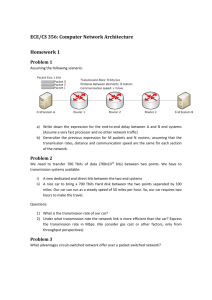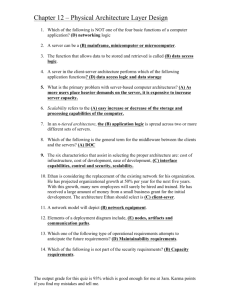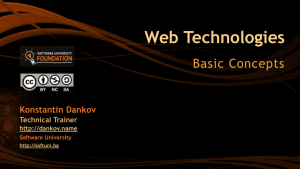Client-server systems Database + Interface with user
advertisement
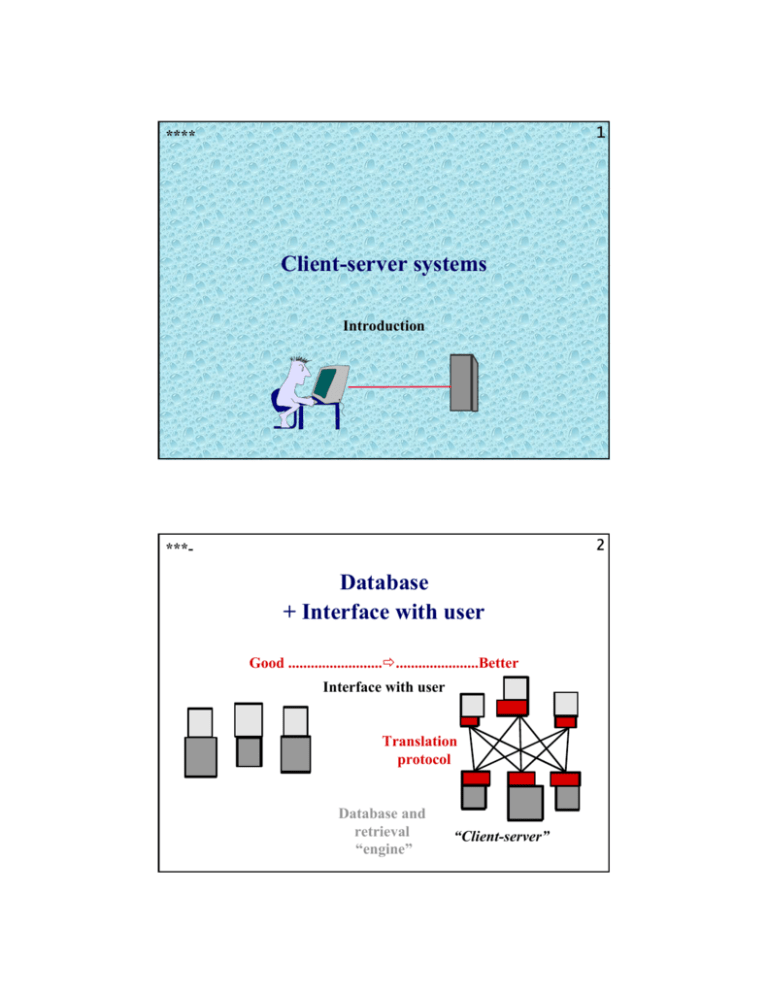
1 **** Client-server systems Introduction 2 ***- Database + Interface with user Good ......................... ......................Better Interface with user Translation protocol Database and retrieval “engine” “Client-server” 3 **** Client-server systems: description • A “client” is a program that runs on the computer which you access in the first place (often your desktop PC or an online access computer). • Each client provides an interface to each of the “services” (databases, online files, e-mail, …) that are made available by other systems, which are called “servers.” 4 **** Client-server computing architecture Client Clientcomputer computer •• isisoften oftenmanaged managedby byaa user userof ofthe theserver’s server’s services, who services, whoisisnot notaa computer computerexpert expert •• sends sendsmessage(s) message(s)// requests requeststo tothe theserver server •• on onwhich whichresults resultsare are prepared and displayed prepared and displayed Server Servercomputer computer •• isisoften oftenmanaged managedby byaa computer computerexpert expert Clientserver protocol •• on onwhich whichinformation information and/or a service and/or a serviceresides resides •• on onwhich whichinformation informationisis prepared preparedfor forthe theclient client 5 **** Client-server database systems: description • The user specifies which database(s) to query and formulates a query, using the client software. • The client software then connects to the database(s) and submits the query, in a structure suitable for communication between client and server. • The server retrieves data from the database, orders these, and returns these to the client. • The client processes the incoming data, and presents them to the user. 6 ***- Client-server database systems: software involved User Client Client software software module module == according User User to the interface interface specific client-server protocol Server Server software software module module == Indexing Indexing ++retrieval retrieval Data 7 **-- Client-server database systems: computers that may be involved User’s User’s personal personal computer computer Queries Queries Buyer Buyer of ofdata data Client Clientcomputer computer Client Clientprogram programto to formulate queries formulate queries Data Dataand and retrieval retrievalengine engine computer computer Data Data//Information Information Intermediary Intermediary Consumer Consumer Waiter Waiterin in restaurant restaurant Seller Seller of ofdata data Cook Cook 8 **-- Client-server systems: specific cases (Part 1) • 1 computer, 1 client/server system Example: a client-server database system used on a personal computer • 2 computers, 1 client/server system ! client software at user’s personal computer + server software at remote server computer ( = most common situation) Examples: telnet, WWW, e-mail, … 9 **-- Client-server systems: specific cases (Part 2) • 2 computers, 2 client/server systems Example: telnet to another computer and on that computer another client/server process 10 **-- Client-server systems: specific cases (Part 3) • 3 computers, 2 client/server systems Example: telnet to another computer and on that computer start of another client/server process with a 3rd computer 11 **-- Client-server systems: “thin” and “fat” clients • Dumb terminal (not really a client) • X- or ICA-terminal (thin client) • Network computer: NC or NetPC (thin or fat client) Increasing Increasing •cost •costof ofhardware hardware •cost of maintenance •cost of maintenance (cost (costof ofownership) ownership) •complexity •complexity •host/server •host/serverindependence independence and andpossible possiblecustomization customization • PC (fat client) 12 **-- Client-server systems: dumb terminals as clients • Wired to a central computer (mainframe or minicomputer). • Not really a client in a client-server system, because programs originate and execute on the central computer, and not on the terminal. • Text-based; only poor graphics built with characters. 13 **-- Client-server systems: X- or ICA-terminals as clients • Networked to a server computer. • Programs originate and execute on the server computer; graphics execute on the terminal. • Example of a “thin” client. 14 **-- Client-server systems: NC network computers as clients • Networked to a server computer. • Programs originate on the server computer, and execute on the server or on the terminal (= the NC network computer, in this case). • Example of a “thin” client. 15 **-- Client-server systems: PCs as clients • In the case of a client-server system: networked to a server computer. • Programs usually originate and execute on the terminal (= PC, in this case), but may also originate and execute on the server computer. • A “fat” client. 16 **-- Client-server systems: thin clients Thin clients can work best in the following situations: • When older, text-based terminals are replaced. • When users work with a limited set of programs. • When users share desktops. • When remote users are difficult to support. • When the applications revolve around remote data instead of local data. • When data security is most important. 17 **** Client-server systems Benefits and problems 18 **** ?? Question ?? Which Whichbenefits benefitsoffers offers the theclient-server client-serverarchitecture architecture to tothe theuser? user? 19 **** Client-server systems: benefits for the user of the system (Part 1) ☺ The user needs to know a smaller number of user interfaces, when more than one server can be accessed by the same client, compared with the case when every system offers its own interface. Client Servers 20 **** Client-server systems: benefits for the user of the system (Part 2) ☺ When more than 1 client is available for a type of server, then the user can make a choice and work with the interface offered by that particular client software, which is well adapted to his/her situation, knowledge and experience. Clients Server 21 ***- Client-server systems: benefits for the distributor of data ☺ The distributor needs to be concerned less with the user interface; instead, his/her server only has to be compatible with the “important” client programs, that is, with one or several important client-server protocols. ☺ Due to the benefits for the user (sometimes = buyer), the number of users / consumers / buyers will grow. 22 **-- Client-server systems: benefits for database system management ☺ The user interface and some other functions can be processed by the (micro)computer of the user, when this executes the client retrieval software. This makes the workload lighter »of the database computer (Which executes the data server software) and »of the data communication network (Which must transfer less data concerned with the user interface) 23 **-- Client-server systems: problem with client programs for Windows • The preferences, history, bookmark, mail and news files of the Windows client programs on the microcomputer can and should be adapted by every user. This is a problem when these files are stored on the hard disk on the client microcomputer, when more than 1 person uses this same microcomputer. • Solution: install the system so that personal files can easily be stored in a personal directory on a drive in the local network. 24 ***-Examples Client-server systems: programs compatible with protocols • The client-server protocols all have one part concerning the client and one concerning the server. • Programs used at the client as well as at the server side can be compatible to a certain extent with such a clientserver protocol. • Compatibility is in most real cases not a full YES or NO. Protocol: Client Server Programs: Client Server 25 **** Client-server systems Examples 26 **** ?? Question ?? Which Whichclient-server client-serverprotocols protocols do you know? do you know? 27 ****Examples Client-server systems: examples in the Internet • nfs • E-mail SMTP • telnet • E-mail POP • ftp • E-mail IMAP • gopher • HTTP (WWW) • News NNTP • Z39.50 28 **** ?? Question ?? Which Whichclient-server client-serverclient clientprograms programs do you know? do you know? 29 **-- ?? Question ?? How Howdo domost mostcomputer computerservices services or orinformation informationand andcommunication communicationservices services think thinkabout aboutthe theclient-server client-serverapproach? approach? What Whatare arethe theconsequences consequences for their work and for their work andworkload? workload? 30 **** Client-server systems Trends 31 **-- ?? Question ?? How Howisisthe theclient-server client-serverapproach approachevolving? evolving? 32 ***-Examples Client-server systems: trends • From few central server computers (mainframes for instance) with dumb terminals, to more server computers with a diversity of “thin” to “fat” client computers. • From Internet client software dedicated to a particular server, to more applications of more generic client software. (Example: incorporation of functions/servers in the WWW accessible with 1 big multipurpose, generic WWW client program.) 33 **** • You are free to copy, distribute, display this work under the following conditions: »Attribution: You must mention the author. »Noncommercial: You may not use this work for commercial purposes. »No Derivative Works: You may not change, modify, alter, transform, or build upon this work. • For any reuse or distribution, you must make clear to others the license terms of this work.
